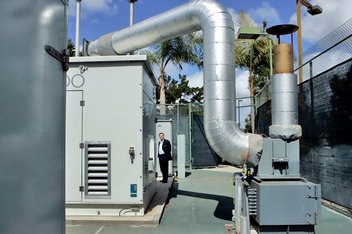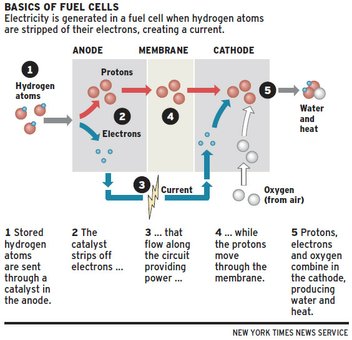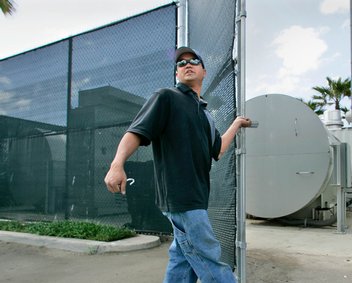 Fueling the future: Fuel cells show promiseMar 7, 2010 - Onell R. Soto - Union Tribune Uses seen for more efficient power generation; companies hope to work out bugs
Fuel cells, which decades ago powered the moon mission, are quietly making their way into businesses and homes, and some see them as the future of power production. Instead of burning fuel to make heat that then drives a turbine, fuel cells use an electrochemical reaction similar to Proponents say today’s fuel cells produce more power from the same amount of fuel than the most efficient gas turbine, create fewer pollutants and give off heat that can prove useful. “There isn’t another technology that can do this, produce power at this high
efficiency at this low emissions at that small a scale,” said fuel-cell researcher Jack Brouwer. Depending on their fuel, the cells also can be considered a renewable source. They can run on methane from a landfill, sewage plant or animal feedlot, said Brouwer, associate director of National Center for Fuel Cell Research at the University of California Irvine. Even if they do run off a fossil fuel such as natural gas, they can help reduce pollutants and greenhouse gases. Fuel cells at the Sheraton San Diego Hotel & Marina have powered lights, televisions, hot showers and heated pools for nearly five years. “They’re very good,” Dave Prost, who oversees the hotel’s buildings and other systems, said of the fuel cells, which are made by Fuel Cell Energy of Connecticut . “We can run almost all of our power with the fuel cells.” Heat from the cells is used to warm a pool and make hot water, keeping Prost’s staff from having to turn on boilers. “That’s free gas, basically,” he said. The county’s other big user is Camp Pendleton , which has a 500-kilowatt system, according to San Diego Gas & Electric Co. Despite the promise of fuel cells, problems including cost, durability and reliability have prevented their wide-scale adoption. Now, several companies are working on perfecting fuel cells. State and federal subsidies are pushing the technology along, with the idea of giving it a boost for the next few years until costs come down. The city of San Diego and the University of California San Diego are cooperating on a fuel-cell project. They plan to trap methane that is now being burned off at the Point Loma Wastewater Treatment Plant and clean it up. Some of the gas will power a fuel cell at that plant, the rest will be put into SDG&E’s natural gas pipelines, and a similar amount will be used to power fuel cells at the university and at a sewage plant in the South Bay. Altogether, the cells will make 4.5 megawatts. Fuel cells aren’t new to the region. SDG&E tested them nearly 20 years ago, said Lee Krevat, who oversees smart-grid projects. “The prices weren’t good enough, at that time, to consider it a viable generation source,” Krevat said. But the power company has remained interested. “We pilot this technology regularly,” Krevat said. “We are very excited about seeing technology where those issues are solved.” Two weeks ago, Bloom Energy , a previously secretive Silicon Valley startup, attracted attention with a coming-out party that included a “60 Minutes” segment, endorsements from Gov. Arnold Schwarzenegger and former U.S. Secretary of State Colin Powell, and deals with eBay , Google and Coca-Cola. Technology Web sites covered the announcement on live blogs as Bloom’s chief executive, K.R. Sridhar , spoke of how toaster-size devices containing his company’s cells could power homes within 10 years. Much of the attention focused on the company’s funding — $400 million from venture capital funds, about one-quarter of that from Kleiner Perkins, which helped Google get off the ground. Bloom says it has mastered some of the problems that stymied earlier fuel-cell efforts, and that its technology is more reliable and durable. Also, its chemistry doesn’t rely on expensive precious metals. A 100-kilowatt Bloom Power Server, also known as a Bloom Box, costs around $700,000, but prices will drop, the company said. That’s enough power for about 65 homes. Bloom isn’t the only company with promise in the industry, Krevat said. “There’s a lot of other vendors out there that also are talking about the same types of potential numbers on costs,” he said. Whether the technology succeeds hangs not only on cost, but how long the fuel cells last and how often they break down, Krevat said. “Depending on how we tweak those variables, we get different uses that make sense,” he said. For instance, Krevat said, a utility like SDG&E can use fuel cells to help it deal with congestion, such as when a neighborhood requires more power than the lines that connect it to power plants can handle. In combination with batteries, it could use them to manage electricity in communities with large numbers of solar-power systems, to deal with a sudden drop in power production when a cloud bank blocks the sun. It’s a different question whether fuel cells will become as common for residential use as solar panels. One company betting that people are ready to put a fuel cell in their backyard is ClearEdge Power of Oregon , which began selling a cell small enough for a large home or a small business in November. The 5-kilowatt units, with incentives and rebates, would set a buyer back about $50,000. The target buyer is someone who can use that much power and take advantage of the heat the system produces for a pool or spa, or make hot water, said company spokesman Mike Upp. “It’s really somebody with a house of 4,000 square feet or above, or a small business like a boutique hotel or restaurant, a spa or a health club,” Upp said. The company has sold about 25 systems so far, and has orders for 300, including some in San Diego County, Upp said. ClearEdge is planning to make presentations for businesses tomorrow afternoon and homeowners tomorrow night at the Center for Sustainable Energy in Kearny Mesa. The center helps arrange for subsidies funded from people’s electric bills. The systems also qualify for federal tax credits. Upp said homeowners will be able to finance the systems through a program debuting this summer that allows people to put the cost on their property taxes. “That’s going to change the game in terms of being able to finance alternative energy,” he said. Onell Soto: (619) 293-1280; onell.soto@uniontrib.com |
Email this page to a friend
If you speak another language fluently and you liked this page, make
a contribution by translating
it! For additional translations check out FreeTranslation.com
(Voor vertaling van Engels tot Nederlands)
(For oversettelse fra Engelsk til Norsk)
(Для дополнительных
переводов проверяют
FreeTranslation.com )




